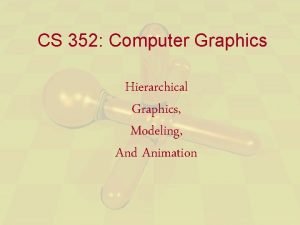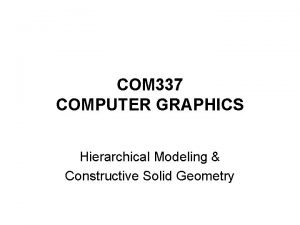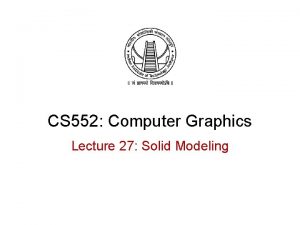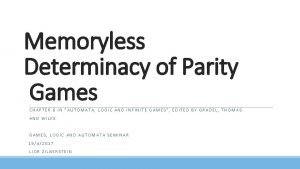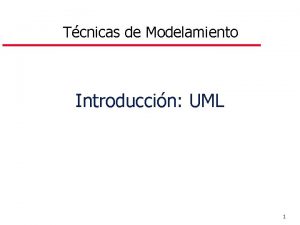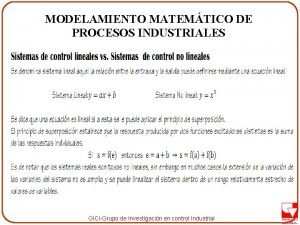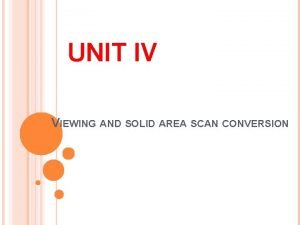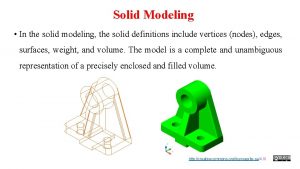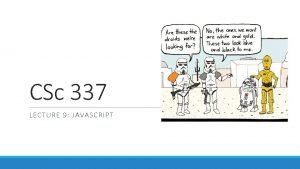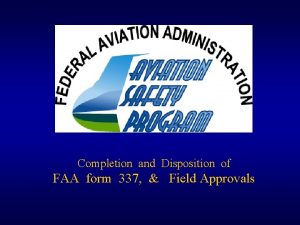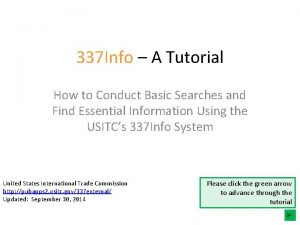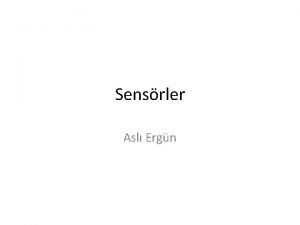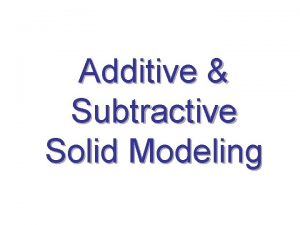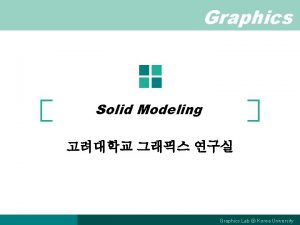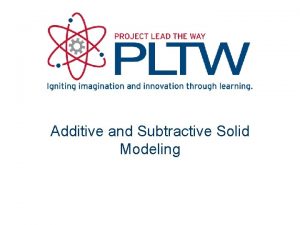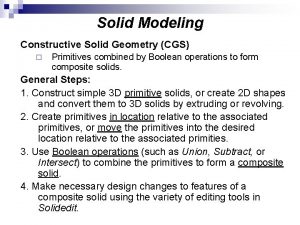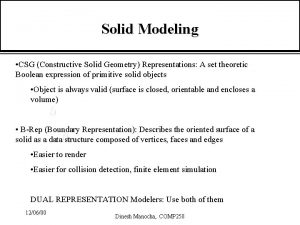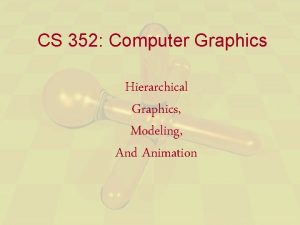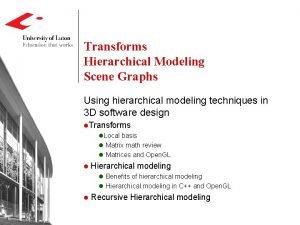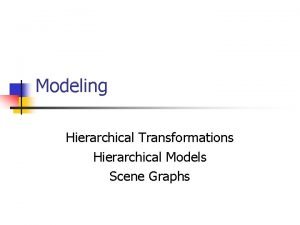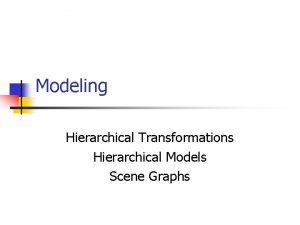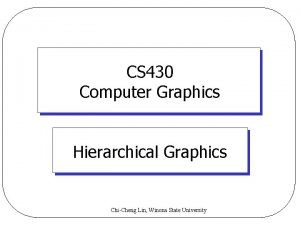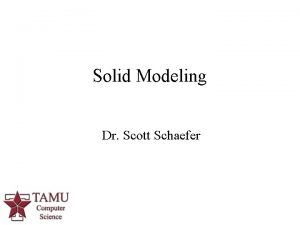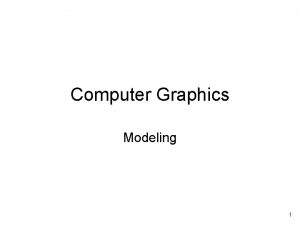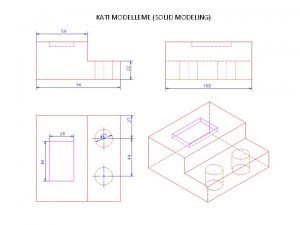COM 337 COMPUTER GRAPHICS Hierarchical Modeling Constructive Solid























- Slides: 23

COM 337 COMPUTER GRAPHICS Hierarchical Modeling & Constructive Solid Geometry

Introduction • When defining a complex object or system, it is easier to § first specify the subparts, § then, describe how the subparts come together • E. g. , a bicycle can be described by § first describing a frame, wheels, fenders, handlebars, seat, chain, and pedals § then positioning these components to form the bicycle

Basic Modeling Concepts • Modeling is the creation and manipulation of • • a system representation A representation of a system is called a model of the system A model can be graphical or purely descriptive (such as a set of equations that describe relationships of system parameters) Graphical models are often called geometric models We will use the term “model” mostly to mean a geometric model

System Representations • The example graphical representation of a logic circuit on the right illustrates features common to many system models § Component parts are shown as geometric structures (symbols) § Relationships between symbols are represented with a network of connecting lines

System Representations • Repeated positioning of a few basic symbols (such as the two and gate symbols) is a common method for building complex models § Each such occurrence of a symbol in a model is called an instance of that symbol • In many cases symbols are dictated but in other cases symbols can be any convenient geometric pattern

System Representations • The information needed to construct and manipulate a model § can be stored in data structures, and/or § can be specified with procedures • In general, a model specification will contain both data structures and procedures, although some models are defined completely with data structures and others use only procedural specifications • In solid modeling, information from data structures (defining coordinates and other things) is used with few procedures • On the other hand, a weather model may need mostly procedures to calculate plots of temperature and pressure variations.

Symbol Hierarchies • Many models can be organized as a hierarchy of symbols • Basic elements for the model can be used to form composite objects (modules), which themselves can be grouped to form higher level objects, and so on …

Hierarchical Models • Suppose that we wish to build a model of an automobile that we can animate • The model can be composed of 5 parts (the chassis and the four wheels) each of which is described using standard primitives

Hierarchical Models • 2 frames of a simple animation of the model are shown below • We can write a program to generate this animation by noting that if each wheel has a radius r, then a 360 degree rotation of a wheel corresponds to the car moving forward (or backward) a distance of 2πr • Program could contain one function to generate each wheel and another to generate the chassis • All functions could use the same input such as the desired speed and direction of the car

Hierarchical Models • This program is just the kind that we do NOT want to write • It does not show the relationships among the components of the car • There are 2 relationships that we want to exploit § We cannot separate the movement of the car from the movement of the wheels § All wheels are identical and merely located in different places with different orientations

Hierarchical Models

Hierarchical Models

Stack-Based Traversal in Application Code • Imagine that we will use a function called figure • • to do the drawing The MV matrix, M, when this function is called will determine the position of the figure The root node (first node) will draw the torso (using M) Next node is the head: function head will be called with MV updated to MMh Then, as we continue with left-upper arm, leftlower arm, right arm, left leg, and right leg, MV will be updated to MMlua, MMlua. Mlll, Mrua, …

Stack-Based Traversal in Application Code • After processing a node, if we go back up to its parent, we need to also roll back the transformation matrix. • This can easily be done by making use of a stack to store (push) copies of matrices and by recovering with popping. • Our code will have transformations mixed with pushes and pops of the MV matrix

Stack-Based Traversal in Application Code var model. View. Matrix = mat 4(); var mv. Stack = [ ]; function figure() { mv. Stack. push(model. View. Matrix); torso(); modelview. Matrix = mult(model. View. Matrix, translate); model. View. Matrix = mult(model. View. Matrix, rotate); head(); model. View. Matrix = mv. Stack. pop(); mv. Stack. push(model. View. Matrix); modelview. Matrix = mult(model. View. Matrix, translate); model. View. Matrix = mult(model. View. Matrix, rotate); left. Upper. Arm(); model. View. Matrix = mv. Stack. pop(); mv. Stack. push(model. View. Matrix); modelview. Matrix = mult(model. View. Matrix, translate); model. View. Matrix = mult(model. View. Matrix, rotate); left. Lower. Arm(); model. View. Matrix = mv. Stack. pop(); mv. Stack. push(model. View. Matrix); model. View. Matrix = mult(model. View. Matrix, translate); model. View. Matrix = mult(model. View. Matrix, rotate); right. Upper. Arm(); ⁞

Stack-Based Traversal in Application Code • • • function torso() { instance. Matrix = Functions for individual parts can be as on the right mult(model. View. Matrix, translate(0. 0, 0. 5*torso. Height, 0. 0)); The textbook first explains a simpler example for a robot instance. Matrix = mult(instance. Matrix, arm with 3 parts scale 4(torso. Width, torso. Height, torso. Width)); Have a look at that example first and try to complete this hierarchical model • If you can complete it, you already have the code for one of the bonuses in the 2 nd assignment } gl. uniform. Matrix 4 fv( model. View. Matrix. Loc, false, flatten(instance)); for (var i = 0; i < 6; ++i) { gl. draw. Arrays(gl. TRIANGLE_FAN, 4*i, 4); }

Stack-Based Application Code vs. Alternative • The example approach has limitations • The code relies on programmer to deal with stacks (push and pops) • The code developed for the example object will not easily extend to another object • Building the model and rendering it is all together, we’d prefer to separate them • A more general and powerful method to work with hierarchies is to implement the tree as a data structure and to render it with a traversal algorithm (See textbook)

Hierarchical Models Summary • Combine smaller/simpler shapes to construct complex objects and scenes • Stored in trees or similar data structures • Operations are based on traversal of the tree • Can keep other information together with the geometry in tree such as transformations, attributes, bounding boxes, etc.

Scene Graphs • • • Directed Acyclic Graphs (DAGs) to represent scenes and complex objects Nodes: Grouping nodes, Transform nodes, Level of Detail (Lo. D) nodes, Attribute nodes, State nodes Leaves: Geometric object descriptions

Constructive Solid Geometry (CSG) • Combine multiple shapes with set operations (intersection, union, set difference) to construct new shapes

CSG

Implementing CSG • Ray casting methods are used for rendering and finding properties of volumes constructed with CSG • Rays are intersected with objects • Intersections are sorted according to the distance • Depending on the operation, extents of the new object can be found

Implementing CSG • Ray casting methods are used for rendering and finding properties of volumes constructed with CSG • Rays are intersected with objects • Intersections are sorted according to the distance • Depending on the operation, extents of the new object can be found
 Hierarchical modeling in computer graphics
Hierarchical modeling in computer graphics Hierarchical modeling in computer graphics
Hierarchical modeling in computer graphics Sweep representation in computer graphics
Sweep representation in computer graphics Bài thơ mẹ đi làm từ sáng sớm
Bài thơ mẹ đi làm từ sáng sớm Cơm
Cơm Constructive proof vs non constructive
Constructive proof vs non constructive Constructive proof vs non constructive
Constructive proof vs non constructive Constructive proof vs non constructive
Constructive proof vs non constructive 22c19
22c19 Graphics monitors in computer graphics
Graphics monitors in computer graphics 3d viewing devices in computer graphics ppt
3d viewing devices in computer graphics ppt I
I Instrumentacion
Instrumentacion Scan conversion in computer graphics
Scan conversion in computer graphics Geometric rotation
Geometric rotation Modeling role modeling theory
Modeling role modeling theory Dimensional modeling vs relational modeling
Dimensional modeling vs relational modeling Solid
Solid _____ defines how solid a color appears.
_____ defines how solid a color appears. 337 form example
337 form example Faa 337
Faa 337 337 form example
337 form example 337info
337info Esneyebilen bir tabaka üzerine ince bir telin
Esneyebilen bir tabaka üzerine ince bir telin
